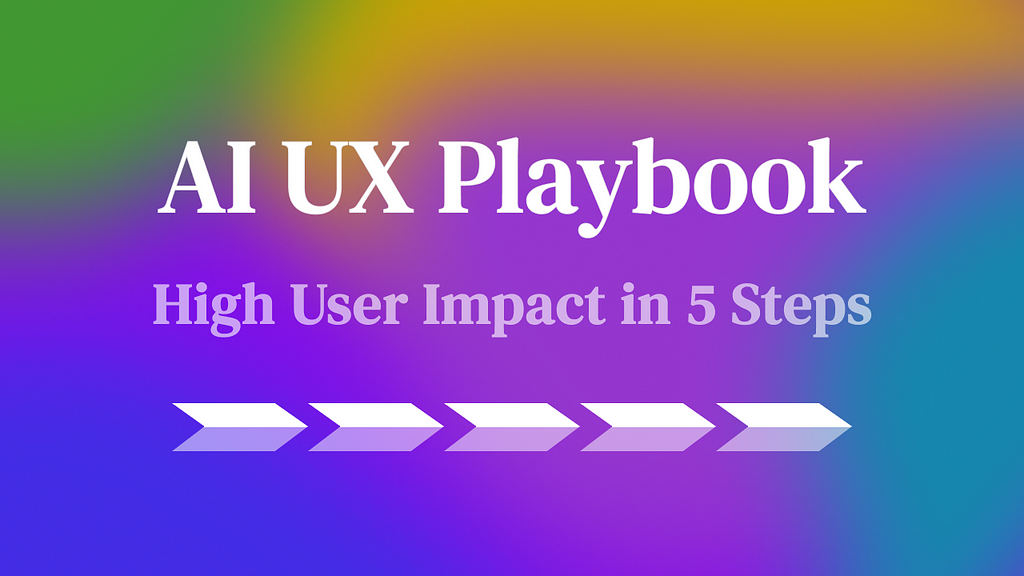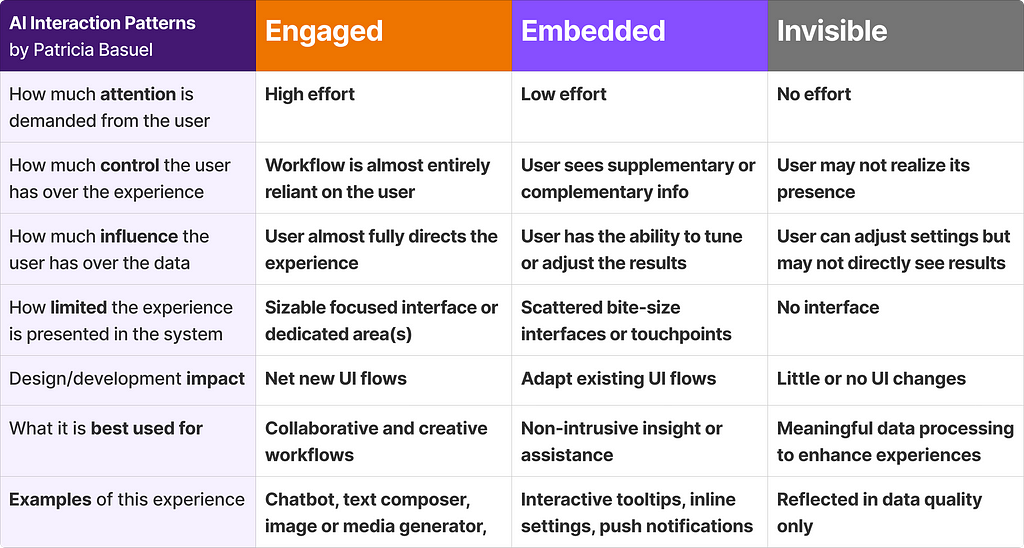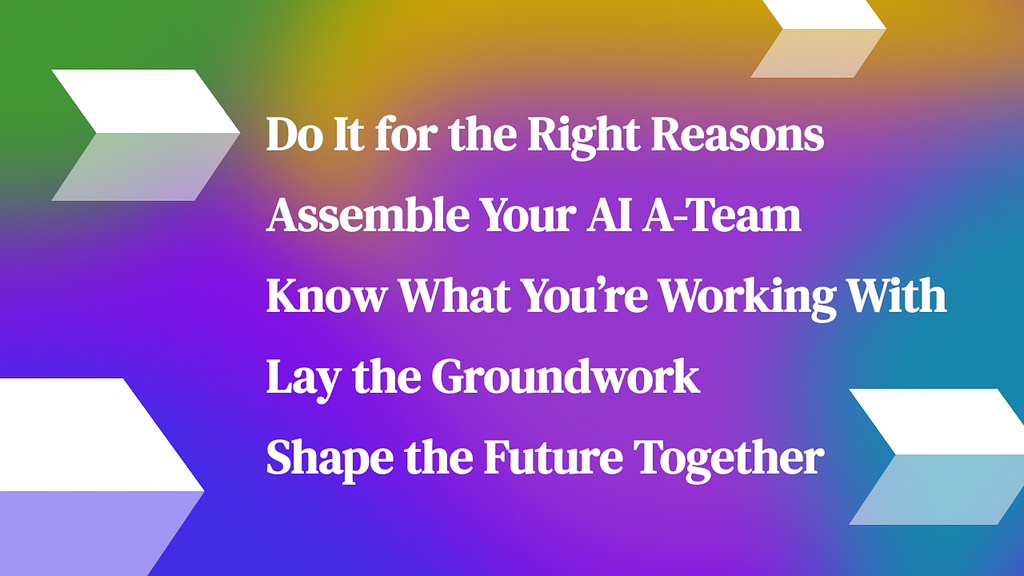
Strategic considerations when crafting AI experiences that drive material improvements for customers.

With everyone rushing to create AI experiences, are products truly hitting the mark? As UX leaders, it’s a privilege to shape product direction. Part of that means thinking about how AI shows up in our experiences and what it actually means for our users.
A recipe for launching transformative AI
It’s not enough to just have AI features anymore. It’s a costly endeavor and, when executed poorly, creates more friction for users. Other designers and technologists have lamented about this before, so I’m not going to rehash it here. So, as a UX leader, how could you best position your company and your team to launch AI effectively?
- Do it for the right reasons
- Assemble your AI A-Team
- Know what you’re working with
- Lay the groundwork
- Shape the future together
Step 1: Do it for the right reasons
Back to basics
Don’t build just for the sake of AI. Identify the most pressing and pervasive problems that users have instead. Red flags to keep in mind:
- Product themes or initiatives that read something like “Generative AI chatbot for our cool product line” instead of “Streamline customer workflows on our cool product line with AI”
- The organization is looking for ways to “add AI” to the product instead of identifying experience flaws or manual interactions that can be 10x or 100x improved by AI
Powwow with product leads, business stakeholders, and customer champions to see what will move the needle. Talk to customers, see how they work, and come back with hard numbers to validate your hypotheses.
Is AI the right call?
Ok, so you identified the big problems, but is AI the right approach? Assessing if artificial intelligence is the right solution by the Centre for Digital Public Services has the guidance to get you started:
- Sufficient data needed is available and safe and ethical to use
- Task is large scale and repetitive enough
- Helpful for achieving outcomes in the real world
Come to Jesus moment
If AI is a good fit, the answer should not always be chatbot, yet many companies think so. If your company does too, then you have some work cut out for you. The primary consideration should be value, and the secret sauce is organizational alignment on what value is.
Define your organization’s AI vision and purpose — Craft this together using pointers from Thrive’s article How to Create an AI Vision Statement. Enhance your UX or product team purpose statement with AI in play.
Step 2: Assemble your AI A-Team
Identify connections who can support your team and its AI initiatives.
- Customer Champions — Find the folks with a direct line to customers
- Ultimate Decision-Makers — Get to know the leaders who approve initiatives and sign the checks, as they say
- Key Influencers — Identify anyone who is passionate about AI or is a trusted advisor within the organization
- Subject Matter Experts — Learn who has the know-how your team needs to consult with
- Executing Functions — Find team members with the right set of skills to execute on your vision

While you may not have the power to mobilize these colleagues or work partners, networking and asking for advice is still helpful in driving your initiatives further.
It is very important to foster relationships across the organization for you to be seen and to build trust.
Getting buy-in & making a buzz
This is the part where you will need to have earnest, maybe sometimes uncomfortable, conversations to inform, collaborate, get approval, or rally various members of your AI A-Team.
- Socialize the vision across the organization
- Validate findings, decisions, and more
- Align on action items and next steps
- Get people excited about the vision and AI journey
Step 3: Know what you’re working with
Orient yourself and your team to better understand the landscape you are building on.
Gauging product intelligence maturity
Where is your organization or product in its intelligence journey? Are you starting from nothing, with a little automation, or with many AI features already? The important part to consider here is current state, not roadmap or a desired future.

- Manual workflows — No automation at all
- Business logic automation — Static business rules for specific functions
- Machine learning & narrow AI — Limited to exceptional proficiency with specific tasks
- General & super AI — Not included in the scale because both are still only theoretical
With an approximation of where your organization stands, you can determine the maturity level your organization must get to in order to achieve the vision.
Assessing platform technical readiness
What is the UI hiding under the covers? Is it built with the proper technical structures to enable AI development? How much tech debt do you need to address before getting to the real AI work?
With architects and developers, your team can make a comprehensive assessment of how well-positioned your platform is. While I do not endorse Domo, they do have a good article AI Readiness: Complete Guide and Free Checklist to Assess Your Business you can reference.
- Foundational readiness — Includes infrastructure platforms, data sources, and software packages
- Operational readiness — Includes guidelines, staffing, governance, compliance, and risk
Knowing this can tell you whether your efforts could be realized, may be delayed, or perhaps in vain.
Step 4: Lay the groundwork
What guides the work
Define AI design principles for impactful UX. You may find inspiration from VUX’s AI Design Principles. Reinforce the established AI vision and purpose with principles that complement and supplement concepts.
What drives the designers
It is important to keep leveling up your UX practice to deliver polished AI.
- Make sure your team stays up-to-date on design best practices, like this article Designing with AI: UX and Best Practices by Maria Margarida
- Actively use AI in your own design workflows to experience AI firsthand and glean insights by doing
- Share prompts, resources, and learnings regularly with one another
- Do what you do every day — honing UX expertise, improving research and design practices, and conducting regular customer engagements
What keeps the team going
Keep regular communication with work partners and follow alignment best practices.
- Know who to involve and when
- Establish asynchronous channels and meeting cadence
What informs the experiences
Is your team eager to start digging into the data? For engineering-minded organizations or to enable a parallel approach, your team can also focus on data preparation. It is feasible to start with cleaning up and prepping datasets that will be used on a basic level and more specialized datasets you know will add to value:
- Account and user data
- Logged application and sensor data
- APIs from required third parties
- Metadata and labels
By cleaning up information and enabling the data to be fed into AI models, you can still work on the current roadmap while being able to gain some ground for AI initiatives. From there, you can let the data guide you when performing deep learning correlations on existing datasets so you can further investigate specific experience use cases.
Step 5: Shape the future together
AI interaction patterns
To solve customer problems with AI, teams must think through how it will live within the system and how it affects the experience. Use the matrix below to guide discussions and decisions.
- Engaged — Demands active, explicit interaction with AI
- Embedded — Curated integrated AI experiences
- Invisible — No direct user interaction with AI



Questions real user advocates ask
- Will this increase interaction demands from users? By how much? Is the effort worth the gains?
- What specific quality of life impacts will this have on our customers? Do they have the ability or will to pay to realize these gains?
- Would implementing this require extra steps for customers to adopt? How much more effort is needed to keep this up when scaled?
Making decisions with compelling research synthesis
Make sure not to miss any opportunities in telling the story of what was learned in discovery, through user feedback, or from analytics. Promptly present findings to business and product stakeholders to ensure roadmap priorities are supported by data.
Visualizing roadmap milestones
The UX team can also be pivotal in helping stakeholders better prioritize work through effective visualization. Work with product managers to mock up hero experiences that represent the end vision, the first step, and a few interim phases before the end can be achieved that map to delivery timelines and phases.
Measuring impact
Ensure you can measure outcomes quantitively and qualitatively. Include ROI (return on investment) for leadership and KPIs (key performance indicators) for product teams. Though I do not endorse them, UX for AI: 10 Tips for Perfecting AI Product Metrics from Arounda offers good examples:
- User engagement, user retention
- Conversion rates, adoption and usage rates
- Efficiency and productivity
The bottom line
If you’re already doing right by your customers, crafting high-impact AI experiences should be a walk in the park. The pitfalls come with misaligned organizational views on AI’s vision or purpose and your product’s technical capabilities not being ready for AI yet. As a design leader, you are uniquely positioned to usher transformational change with a little digging, some networking, and out of the box thinking.

Further Reading
- Generative AI UX Design Patterns – Useful for thinking through AI touchpoints for microinteractions all the way to product ecosystems
- 10 AI Design Patterns for Enterprise Software and Their Real-World Applications – Highlights specific ways to embed AI experiences that foster better collaboration with users
- The Ultimate Collection of Generative AI-UX Interactions – Curated examples for inspiration
The 5-step AI UX playbook to deliver high-impact products was originally published in UX Collective on Medium, where people are continuing the conversation by highlighting and responding to this story.